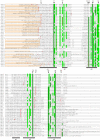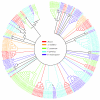The odorant binding protein gene family from the genome of silkworm, Bombyx mori
- PMID: 19624863
- PMCID: PMC2722677
- DOI: 10.1186/1471-2164-10-332
The odorant binding protein gene family from the genome of silkworm, Bombyx mori
Abstract
Background: Chemosensory systems play key roles in the survival and reproductive success of insects. Insect chemoreception is mediated by two large and diverse gene superfamilies, chemoreceptors and odorant binding proteins (OBPs). OBPs are believed to transport hydrophobic odorants from the environment to the olfactory receptors.
Results: We identified a family of OBP-like genes in the silkworm genome and characterized their expression using oligonucleotide microarrays. A total of forty-four OBP genes were annotated, a number comparable to the 57 OBPs known from Anopheles gambiae and 51 from Drosophila melanogaster. As seen in other fully sequenced insect genomes, most silkworm OBP genes are present in large clusters. We defined six subfamilies of OBPs, each of which shows lineage-specific expansion and diversification. EST data and OBP expression profiles from multiple larvae tissues of day three fifth instars demonstrated that many OBPs are expressed in chemosensory-specific tissues although some OBPs are expressed ubiquitously and others exclusively in non-chemosensory tissues. Some atypical OBPs are expressed throughout development. These results reveal that, although many OBPs are chemosensory-specific, others may have more general physiological roles.
Conclusion: Silkworms possess a number of OBPs genes similar to other insects. Their expression profiles suggest that many OBPs may be involved in olfaction and gustation as well as general carriers of hydrophobic molecules. The expansion of OBP gene subfamilies and sequence divergence indicate that the silkworm OBP family acquired functional diversity concurrently with functional constraints. Further investigation of the OBPs of the silkworm could give insights in the roles of OBPs in chemoreception.
Figures








Similar articles
-
The Lepidoptera Odorant Binding Protein gene family: Gene gain and loss within the GOBP/PBP complex of moths and butterflies.Insect Biochem Mol Biol. 2015 Jul;62:142-53. doi: 10.1016/j.ibmb.2015.03.003. Epub 2015 Mar 14. Insect Biochem Mol Biol. 2015. PMID: 25784631
-
Function and evolution of a gene family encoding odorant binding-like proteins in a social insect, the honey bee (Apis mellifera).Genome Res. 2006 Nov;16(11):1404-13. doi: 10.1101/gr.5075706. Epub 2006 Oct 25. Genome Res. 2006. PMID: 17065610 Free PMC article.
-
Identification and expression pattern of the chemosensory protein gene family in the silkworm, Bombyx mori.Insect Biochem Mol Biol. 2007 Mar;37(3):266-77. doi: 10.1016/j.ibmb.2006.11.012. Epub 2006 Dec 14. Insect Biochem Mol Biol. 2007. PMID: 17296501
-
The 40-Year Mystery of Insect Odorant-Binding Proteins.Biomolecules. 2021 Mar 30;11(4):509. doi: 10.3390/biom11040509. Biomolecules. 2021. PMID: 33808208 Free PMC article. Review.
-
Genome-wide identification and characterization of Fox genes in the silkworm, Bombyx mori.Funct Integr Genomics. 2015 Sep;15(5):511-22. doi: 10.1007/s10142-015-0440-5. Epub 2015 Apr 17. Funct Integr Genomics. 2015. PMID: 25893708 Review.
Cited by
-
Identification of Olfactory Genes From the Greater Wax Moth by Antennal Transcriptome Analysis.Front Physiol. 2021 May 19;12:663040. doi: 10.3389/fphys.2021.663040. eCollection 2021. Front Physiol. 2021. PMID: 34093226 Free PMC article.
-
Predicted structure of a Minus-C OBP from Batocera horsfieldi (Hope) suggests an intermediate structure in evolution of OBPs.Sci Rep. 2016 Sep 23;6:33981. doi: 10.1038/srep33981. Sci Rep. 2016. PMID: 27659921 Free PMC article.
-
Antennal transcriptome analysis of olfactory genes and characterizations of odorant binding proteins in two woodwasps, Sirex noctilio and Sirex nitobei (Hymenoptera: Siricidae).BMC Genomics. 2021 Mar 10;22(1):172. doi: 10.1186/s12864-021-07452-1. BMC Genomics. 2021. PMID: 33691636 Free PMC article.
-
Mutually Exclusive Expression of Closely Related Odorant-Binding Proteins 9A and 9B in the Antenna of the Red Flour Beetle Tribolium castaneum.Biomolecules. 2021 Oct 12;11(10):1502. doi: 10.3390/biom11101502. Biomolecules. 2021. PMID: 34680135 Free PMC article.
-
Silencing the Odorant Binding Protein RferOBP1768 Reduces the Strong Preference of Palm Weevil for the Major Aggregation Pheromone Compound Ferrugineol.Front Physiol. 2018 Mar 21;9:252. doi: 10.3389/fphys.2018.00252. eCollection 2018. Front Physiol. 2018. PMID: 29618982 Free PMC article.
References
Publication types
MeSH terms
Substances
LinkOut - more resources
Full Text Sources
Research Materials

